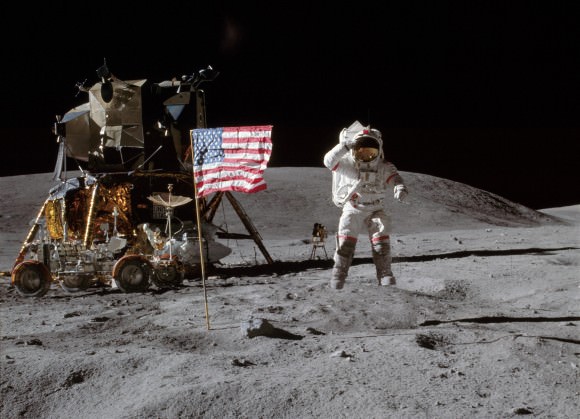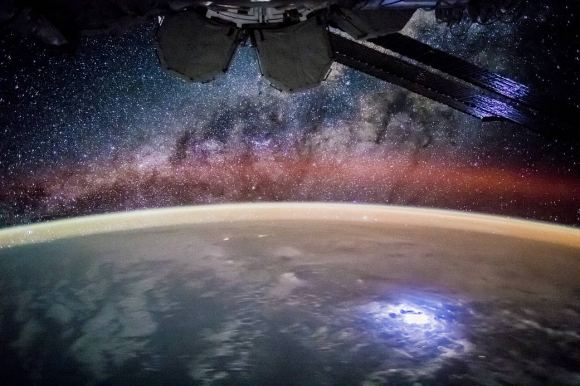I've often been asked the question, "Can the astronauts on the Space Station see the stars?" Astronaut Jack Fischer provides an unequivocal answer of "yes!" with a recent post on Twitter of a timelapse he took from the ISS. Fischer captured the arc of the Milky Way in all its glory, saying it "paints the heaves in a thick coat of awesome-sauce!"
But, you might be saying, "how can this be? I thought the astronauts on the Moon couldn't see any stars, so how can anyone see stars in space?"

John W. Young on the Moon during Apollo 16 mission. Charles M. Duke Jr. took this picture. The LM Orion is on the left. April 21, 1972. Credit: NASA
It is a common misconception that the Apollo astronauts didn't see any stars. While stars don't show up in the pictures from the Apollo missions, that's because the camera exposures were set to allow for good images of the bright sunlit lunar surface, which included astronauts in bright white space suits and shiny spacecraft. Apollo astronauts reported they could see the brighter stars if they stood in the shadow of the Lunar Module, and also they saw stars while orbiting the far side of the Moon. Al Worden from Apollo 15 has said the sky was "awash with stars" in the view from the far side of the Moon that was not in daylight.
Just like stargazers on Earth need dark skies to see stars, so too when you're in space.
The cool thing about being in the ISS is that astronauts experience nighttime 16 times a day (in 45 minute intervals) as they orbit the Earth every 90 minutes, and can have extremely dark skies when they are on the "dark" side of Earth. Here's another recent picture from Fischer where stars can be seen:
For stars to show up in any image, its all about the exposure settings. For example, if you are outside (on Earth) on a dark night and can see thousands of stars, if you just take your camera or phone camera and snap a quick picture, you'll just get a darkness. Earth-bound astrophotographers need long-exposure shots to capture the Milky Way. Same is true with ISS astronauts: if they take long-exposure shots, they can get stunning images like this one:

This long exposure image of the night sky over Earth was taken on August 9, 2015 by a member of the Expedition 44 crew on board the International Space Station. Credit: NASA.
This image, set to capture the bright solar arrays and the rather bright Earth (even though its in twilight) reveals no stars:
In this timelapse of Earth at night, a few stars show up, but again, the main goal here was to have the camera capture the Earth:
Universe Today's Bob King has a good, detailed explanation of how astronauts on the ISS can see stars on his Astro Bob blog Astrophysicist Brian Koberlein explains it on his blog, here.
You can check out all the images that NASA astronauts take from the ISS on the "Astronaut Photography of Earth" site, and almost all the ISS astronauts and cosmonauts have social media accounts where they post pictures. Jack Fischer, currently on board, tweets great images and videos frequently here.
No comments:
Post a Comment